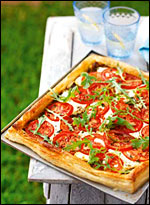As the date for Slow Food Nation — the big sustainable-food conference scheduled in San Francisco this coming August — draws near, I’ve been thinking about attitudes toward food in the erstwhile Fast Food Nation. Like a big pot of water that’s been on high heat seemingly forever, our national conversation on food seems to be reaching a boil at long last.

Slow Food Nation.
Now, my world revolves around food, so I may not be the most reliable gauge of such things. I have a tendency to assume everyone shares my obsession — to the point where I am often taken aback when people tilt their heads quizzically if I mention things like “sustainable fisheries,” “food deserts” (not “desserts”) or “Slow Food.” I say to myself, How can this person not know about these things? How can someone not know how to make pasta? Who doesn’t know that there are 3 teaspoons in a tablespoon?
Of course, my wife reminds me that I can’t change the oil in my car or fill out a 1040EZ. Different people fixate on different things — and (I’m told) not all of them are food-related. I get it.
However, more and more people do seem to be looking beyond the Golden Arches toward a more delicious and sustainable food future. Over the past several years, we’ve seen a steady stream of food-related New York Times bestsellers (see books by Schlosser, Pollan, Kingsolver, Nestle, and Nabhan). And last week, the powerful National Restaurant Association — that other, even more conservative NRA — jumped on the green-food bandwagon.
At the NRA’s annual convention in Chicago, Steve Ells, founder/chair/CEO of Chipotle Mexican Grill, addressed restaurant-industry suits about sustainable practices in food, buildings, and staff. (Chipotle has wowed even hardcore industry critics with its zeal for buying sustainably produced meat.) And it didn’t stop there. California power company PG&E put together a Green Food Service Technology Center — and even held a seminar on “Operating Green with a Triple Bottom Line.”
Stomping on the Shoulders of Giants
Now many will argue that it is not always a good thing when corporate giants adopt such practices. Many of us remember the hollering that resulted from Wal-Mart’s entrance into the organic food biz a couple of years ago. Fears of usurpation of ideas and exploitation of beliefs on false pretenses are legitimate. But can we afford to dismiss these actions on their face, simply because they’re being concocted by corporate types in Prada and Armani? Doing so in the past has only relegated sustainable practices to the realm of the lunatic fringe — the weird stuff that only granola-crunchin’-pinko-hippie-treehuggers do.
Eating locally and low on the food chain, growing your own food, composting, recycling, using CFL bulbs, driving hybrid cars — those are all wonderful things. But if they’re practiced by only a few, the impact fades. If we chastise Wal-Mart for carrying organic food, or mock Ted Turner for greening his steakhouse chain, why on earth wouldn’t the corporate suits just say “Fine, screw ya then, why should we bother?”
So instead we ought to say to the Chipotle Grills of the world, “Hey, that’s pretty cool that you only serve meat raised under the Animal Welfare Institute’s humane practices guidelines. Thanks a bunch for doing that. Here’s another idea for going even further. Why not look into supporting a rare breed — such as those championed by the American Livestock Breeds Conservancy?” We should show them the next step, not attack them for taking the first one.
That’s what my involvement with Slow Food has taught me: that rethinking the food system involves conversation and sharing, not proselytizing or drumbeating. We need to be inviting people of all kinds to come to the table. As a chef, I have sought to provide tasty, fresh food to my guests throughout my career. But Slow Food’s ideals have shown me that what we eat has profound effects not just on our bodies and palates, but also on our relationships with each other and the earth.
In an effort to reach as diverse an audience as possible, the great bulk of Slow Food Nation, which takes place Labor Day weekend, will be free and open to the public. I hope you will consider joining us in San Francisco in the effort to improve the food system. In the meantime, here’s a recipe from my forthcoming book A Cook’s Journey: Slow food in the Heartland. I picked it up from Missouri home cook Martha Folk.
Niçoise Tart with Goat Cheese and Tomatoes
This recipe uses a frozen puff-pastry dough. Of course, fresh puff dough is far better, but even devoted Slow Foodies like myself recognize that the time and expertise needed to make homemade puff pastry dough is beyond the reach of most home cooks. By all means though, make it if you can, or ask a local bakery to prepare some for you.
Ingredients
2 tablespoons olive oil
Salt and fresh cracked black pepper, to taste
1 sheet frozen puff pastry (8″ x 10″)
1/2 cup sun-dried tomato paste or pesto
1 4 oz. round fresh, preferably local goat cheese, such as that from Missouri’s Goatsbeard Farm
2 or 3 heirloom tomatoes, sliced
1/2 cup Niçoise olives, halved and pitted
3 tablespoons chopped fresh herbs — basil and/or thyme
Yolk of one egg, beaten lightly with a fork
Heat olive oil over medium flame, then add onion. Reduce to medium-low and cook slowly, stirring occasionally, until onion is caramelized, about 30 minutes. Season with salt and fresh-cracked black pepper.
Preheat oven to 425°.
Lay the puff pastry on cookie sheet or baking stone. With a sharp knife, score a center section approximately 1 inch from edge (don’t cut all the way through). This will “puff” into a border for the tart. Spread the inner rectangle with dried-tomato paste or pesto. Arrange cheese, tomatoes, olives, and herbs on top. Drizzle with additional olive oil. Brush outer frame of tart with egg yolk. Cook at 425° for 5 minutes, and then lower heat to 375° for about 10 minutes or until brown and bubbly.
Remove and let rest for 4 or 5 minutes before slicing, then serve immediately.
Serves 4 as a light lunch or 6 as an appetizer.




